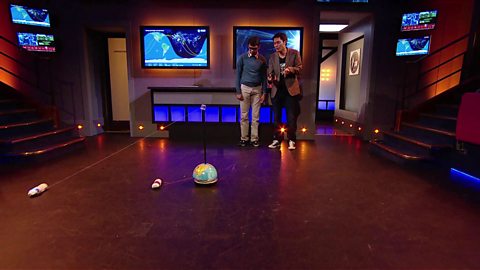Kevin Fong explains that a space capsule like the Soyuz heats up on re-entry not from friction with air molecules, but because it compresses the air in front of it.
He demonstrates this by compressing the air in a glass tube using a plunger and the increase in air temperature is sufficient to ignite some cotton wool in the bottom of the tube.
The heat shield on the Soyuz capsule is made from a solid silica foam which is mostly air and thus has a very low thermal conductivity.
A cube of this heat shield material is removed from a kiln at 1100 degrees Celsius and after cooling for only a matter of seconds, Kevin picks it up with his bare hands.
It is still red hot in the centre, but its material properties prevent the heat from conducting out to the edges of the cube, which have already cooled down.
This clip is from the Royal Institution Christmas Lectures 2015.
Teacher Notes
Key Stage 3
After watching this clip, you could ask students to research some of the materials that have been developed for space programmes around the world.
They could investigate what these materials are used for now.
Key Stage 4
Students can research materials with low and high thermal conductivity and complete calculations on the amount of thermal energy transferred across them when one side’s temperature increases to that typical of re-entry.
Curriculum Notes
This clip will be relevant for teaching Physics.
This topic appears at KS3 and in OCR, Edexcel, AQA, WJEC KS4/GCSE in England and Wales, CCEA GCSE in Northern Ireland and SQA National 4/5 in Scotland.
More from the Royal Institution Christmas Lectures 2015
What is Newton's Cannon and Third Law? video
Dr Kevin Fong demonstrates projectile motion, orbit and Newton’s Third Law.

Using Earth’s rotation to launch a rocket. video
Dr Kevin Fong demonstrates how a space rocket’s launch direction affects its success in reaching orbit.

How the vacuum of space affects the human body. video
Dr Kevin Fong does a demonstration to show the lethal effects of a vacuum on the human body.

Resonant Frequency. video
Dr Kevin Fong explains how sound vibrations could pose a real threat astronauts and rockets in space.

Orbital Rendezvous. video
Dr Kevin Fong demonstrates how and why it's so hard for a spacecraft to catch up with the International Space Station.

What does gas weigh? video
A demonstration that carbon dioxide can be poured because it is denser than air.

Why are bones weaker in orbit? video
Kevin Fong explains how micro-gravity can weaken bones. Models are used to show that bones are strong but light, and how low gravity weakens them.

How micro-gravity disorientates us. video
A demonstration of how dizziness occurs during motion sickness or micro-gravity.

The danger of orbital debris. video
Dr Kevin Fong and NASA astronaut Dan Tani explain the danger of space debris.

Why Earth rock is found on the Moon. video
Dr Kevin Fong demonstrates how debris from meteorites hitting Earth threw Earth rock as far as the Moon, leaving clues there about Earth’s geological history.

Demonstrating radiation detectors. video
Dr Kevin Fong shows how a Geiger-Muller tube can detect ionising radiation but not the type of radiation, and how detectors on the International Space Station can.

How Earth protects us from radiation. video
Dr Kevin Fong discusses the dangers to astronauts of solar radiation, and how we’re protected from it by Earth’s atmosphere and magnetic field.

Why tardigrades can survive in orbit. video
Dr Kevin Fong explains why tardigrades are so resilient when exposed to ionising radiation lethal to most other organisms.

How to recycle urine in space. video
Dr Kevin Fong demonstrates a urine recycling system that works using osmosis, concluding by drinking the liquid that is produced.

Ã˝